- svg]:fill-accent-900">

Meet China’s triple-hulled warship of the future
By Jeffrey Lin and P.W. Singer
Posted on Feb 23, 2017 9:44 PM EST
4 minute read
At the Dubai IDEX defense exposition, arms makers from around the world show off their latest wares. A notable debut at the recent 2017 show: a new, triple hulled Chinese warship design.
While showing off a model of the planned ship, China Shipbuilding Trading Company announced that it is aiming to start construction on a “trimaran” warship in 2018 for the People’s Liberation Army Navy (PLAN).
The Chinese navy already uses smaller trimaran ships for noncombat missions—think training torpedo recovery, search and rescue, and oceanographic research.
So what exactly are trimaran ships? The major distinction is they three hulls: one large, central one and two rearward smaller hulls connected by decks or girders. The design is used in the U.S. Navy’s new USS Independence subclass of the Littorial Combat Ship, and in fact the new Chinese ship looks very similar to that class.
The design means the ships have the advantage of a wider deck to operate more aircraft; this frigate design has a two-door hangar for helicopters and vertical take-off landing (VTOL) unmanned aircraft systems (UAS). Trimarans can also reach higher speeds, due to the reduced drag of having three hulls instead of a single wider one.
The Chinese trimaran frigate will be about 465 feet long, and has a beam of 105 feet and a weight of 2,450 tons. Interestingly, it may be the first Chinese warship to use an integrated electrical propulsion system (IEPS) to provide the power for driving its three pumpjets. It is unclear if the announced 2,450-ton displacement is full or light.
If we’re comparing the vessel to the USS Independence subclass of the Littorial Combat Ship, the latter is designed as a high-speed platform, with a top speed estimated at 50 knots, which is faster than the Chinese trimaran frigate’s announced 30-35-knot top speed. The Chinese trimaran frigate is far more heavily armed for conventional warfare; the American ship mounts only a 57mm cannon plus provisions for anti-ship missiles while the Chinese ship boasts the capacity for a 76mm cannon, anti-ship missiles, and vertical-launching system cells for carrying anti-ship, land attack cruise and anti-air missiles.
That being said, the USS Independence offers the flexibility of changing out mission modules (such as between anti-submarine and mine countermeasure missions). This flexibility may be overstated, however, as both trimaran designs have wide decks for intensive helicopter operations, and the Chinese version also appears to have ample cargo spaces to embark maritime special forces and unmanned surface and underwater systems.
If built, the trimaran frigate would provide the PLAN with a high-speed, heavily armed warship for littoral operations in the East and South China Seas. It would likely serve as a complement to smaller Type 022 stealth missile boats and Type 056 corvettes; fast enough to keep up with them, and provide them with area air defense and helicopter coverage. Its space for special operations and aviation units also makes it a candidate for Chinese special operations in the littoral environment, and its speed makes it a good rapid-response unit to regional emergencies. Finally, its large carrying capacity could come into play as a heavily armed mothership and command center for Chinese drones, unmanned boats, and submarine robots. If the PLAN does buy this trimaran frigate, it’ll have a warship that will open up new places in high paced 21st-century naval combat.
You may also be interested in:
China’s New Aircraft Carrier Hints at the Future of Its Navy
China’s Largest Surface Warship Takes Shape
New Chinese Catamaran Spy Ship Learns All About Japanese Water
Latest in Military
The tech that changed elections forever the tech that changed elections forever.
By Popular Science Team
‘Militarized’ Cybertrucks are coming—if you can open the doors ‘Militarized’ Cybertrucks are coming—if you can open the doors
By Andrew Paul

- Search forums
Follow along with the video below to see how to install our site as a web app on your home screen.
Note: This feature may not be available in some browsers.
- Secret (Unbuilt) Projects
- Secret Naval Projects
Stealth Trimaran Aircraft Carrier (STAC)
- Thread starter Triton
- Start date 13 March 2009
Donald McKelvy
- 13 March 2009
The 40,000 ton Stealth Trimaran Aircraft Carrier (STAC) could operate an air wing of up to 55 aircraft using both ski-jump for STOVL aircraft and 450ft (140m) long diagonal deck for launching CTOL aircraft. Anyone have additional concept art or better scans of the concept art attached for the STAC?
Attachments
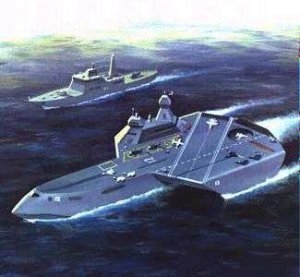
cluttonfred
Access: top secret.
I don't think I've ever seen a carrier flight deck angled so far off the centerline before. Seems a bit much....
ACCESS: Confidential
Just got around to converting the PDFs on My Avpro CDs to jpeg so here's the pics in the original size. And that cross wind is going to a b$#$^

Cheers dragon72 . ;D ;D You wouldn't have anymore images you would be willing to share from the Avpro CDs?
Charles Gray
Access: restricted.
I was told that this AVPRO apparently was a company that never actually produced anything other than CD's and brochures (as opposed to the other AVPRO), so i'm rather dubious about the feasiblity of their design.
Charles Gray said: I was told that this AVPRO apparently was a company that never actually produced anything other than CD's and brochures (as opposed to the other AVPRO), so i'm rather dubious about the feasiblity of their design. Click to expand...
- 14 March 2009
I've seen pictures that might be a post CVX carrier that were trimaran, but never that design. And to be honest, "Interest" often seems to mean "someone somewhere came up with an artist conception of what it might look like." I'm not aware of any sign that the navy ever seriously considered a trimaran design for a post CVX carrier.
Thanks for the images, dragon72, these are by some way the clearest AVPRO scans I've seen. Triton mentioned "Warplanes of the Future", and "X-Planes" by the same authors is in my local library; does the CD offer much more in the way of images?
ACCESS: Above Top Secret
Avpro is a conceptual design and research company committed to design excellence, and the advancement of aerospace and defence technology. The company works closely with the UK aerospace and defence industry, and has an excellent working relationship with the UK Defence Evaluations and Research Agency (DERA). These links enable Avpro to offer a custom design service for air, sea and land platforms to customer's requirements and specifications. The company's conceptual design portfolio ranges from the EXINT Pod rescue system, conceived for the recovery of downed aircrew using the Harrier vertical take off and landing aircraft and Apache helicopter, to the radical stealth trimaran aircraft carrier (STAC) designed to outperform all current aircraft carriers in such parameters as speed, stability, safety and survivability. Avpro is justifiably proud of its association with the UK armed forces and can offer other governments impartial and professional advice in respect of equipment and military capabilities. The company can also provide direct support to military commanders in developing concepts of operation and tactics for existing and planned forces. In today's uncertain world Avpro is committed to providing highly innovative concepts which keep defence capabilities ahead of any adversary. Click to expand...
All hail the God of Frustration!!!
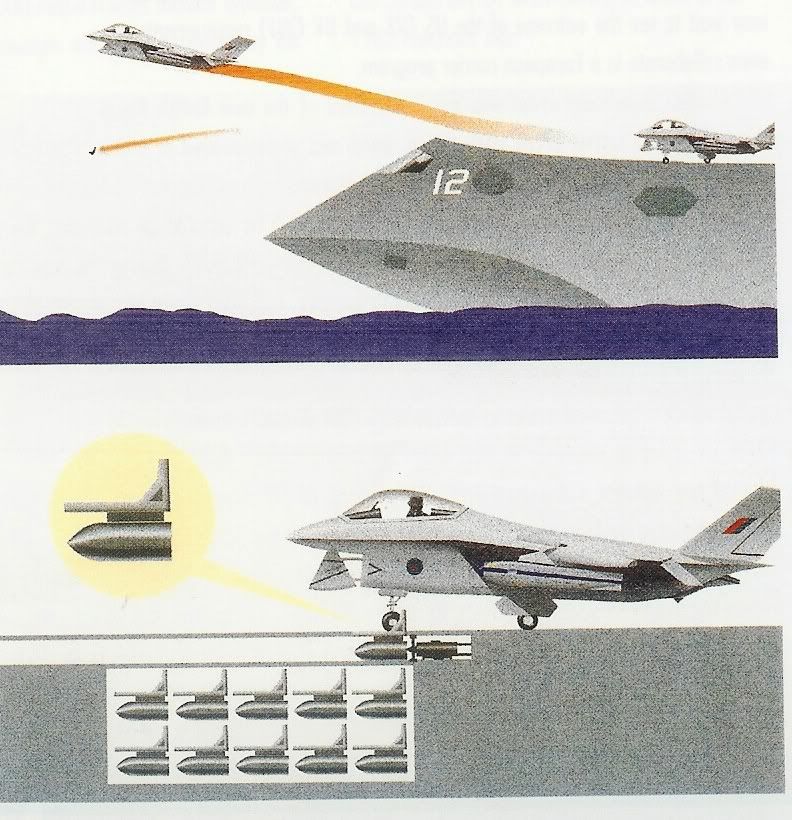
GTX said: They were around in the late '90s. They also set up a USA based arm if I remember correctly. They vanished though around 2001. Apart from the EXINT pod I don't believe anything else came close to the hardware stage. They did however have some very interesting concepts - my favourites were the Proteus Modular UCAV/Cruise Missile; the Titan large Stopped rotor transport, and some of their UCAV designs. One interesting aspect of the STAC was the proposed launch system - instead of a steam catapult, it was proposed to use a cartridge based launch system - see pic: Regards, Greg Click to expand...
If you look at the STAC drawings you will see that it was far from being "yet another light carrier concept." Regards, Greg
- 15 March 2009
Merv_P said: Thanks for the images, dragon72, these are by some way the clearest AVPRO scans I've seen. Triton mentioned "Warplanes of the Future", and "X-Planes" by the same authors is in my local library; does the CD offer much more in the way of images? Click to expand...
GTX said: One interesting aspect of the STAC was the proposed launch system - instead of a steam catapult, it was proposed to use a cartridge based launch system Click to expand...
Demon Lord Razgriz
Is there any stats on this carrier? Like the measurements of it.
- 16 March 2009
Using the planview, which shows several V-22 Ospreys, too, I would think, length is around 330m, maximum width about 122m ... ???
XP67_Moonbat
I presume that because the ship doesn't have a funnel it is nuclear powered?
hole in the ground
Access: secret.
- 17 March 2009
possibly the funnels vent into the space between hulls? reducing IR signiture?
- 31 March 2009
Is there anymore pics of this carrier, perferably high quaility & large. I'm trying to draw it Shipbucket style and those patches on the side of the main hull is really driving me crazy trying to figure out what the heck they are. Oh, and on that last pic Dragon posted, does anybody have any good pics of those fighters?
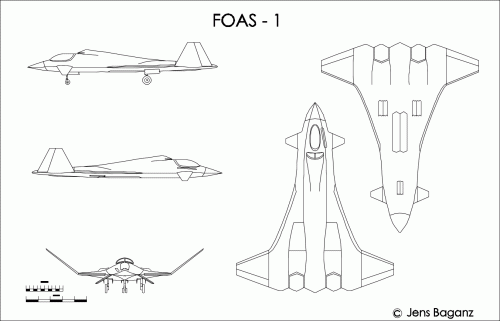
ACCESS: USAP
"Shouldn't that AvPro stuff go in the Fantasy section?" Well, some of them are quite near to those from the movie "Stealth", I think ! But as was pointed out in another thread, judging this company seems to be a little bit difficult. At least, they had one or two concepts, that looked quite real (exint pod and this modular cruise missile).
Jemiba said: "Shouldn't that AvPro stuff go in the Fantasy section?" Well, some of them are quite near to those from the movie "Stealth", I think ! But as was pointed out in another thread, judging this company seems to be a little bit difficult. At least, they had one or two concepts, that looked quite real (exint pod and this modular cruise missile). Click to expand...
Oh, thank you Jemiba. Those pics are exactly what I wanted, now all I need is more pics & details on the carrier. ;D
sferrin said: Shouldn't that AvPro stuff go in the Fantasy section? Click to expand...
I see the truth in it.
Right but if it's just some made up design it's still a made up design. Click to expand...
Avpro had a distinctly fly by night feel to me. Their "Investor's Club" fundraising scheme from 2000/01 was quite possibly an illegal stock offering, which doesn't make me feel good about the credibility of their technical proposals. They were a step above the Stavattii (sp?) Aerospace folks, in that they apparently did produce some hardware on one project, but otherwise they looked very sketchy.
Lampshade111
- 9 April 2009
An interesting concept regardless of their credibility. Such a ship looks possible although it's layout would probably be a bit different.
I just picked up a copy of Warplanes of the Future (about $7 used). The section on the "Stealth Trimaran Aircraft Carrier" gives a few more details. The diagonal flight deck is said to be 450 ft (130m) long, which makes the overall length about 920 ft (280m). Displacement was reported as approximately 40,000 tonnes, with a capacity of 55 aircraft. As speculated, exhaust would vent between the center and sidehulls. Speed was to exceed 40 knots, but no other details of power levels or prime movers was mentioned. Launch arrangements are confused. In one place, it mentions an electromagnetic catapult on the port sidehull for launching aircraft like Typhoon, Rafale, and F/A-18E. However, measuring off the drawing shows this catapult track to be about 130 feet long, which is only half as much as a C-13-1 steam catapult. It's hard to imagine that an electromagnetic catapult could do the job in half the length, even with the smoother acceleration profile it offers over steam. Elsewhere, it mentions the projectile-based catapult, with drawings suggesting it would work along the angled ski-jump. The various dark spots along the hull seem to be phased array emitters of various unspecified sorts.
- 10 April 2009
TomS said: I just picked up a copy of Warplanes of the Future (about $7 used). The section on the "Stealth Trimaran Aircraft Carrier" gives a few more details. The diagonal flight deck is said to be 450 ft (130m) long, which makes the overall length about 920 ft (280m). Displacement was reported as approximately 40,000 tonnes, with a capacity of 55 aircraft. As speculated, exhaust would vent between the center and sidehulls. Speed was to exceed 40 knots, but no other details of power levels or prime movers was mentioned. Launch arrangements are confused. In one place, it mentions an electromagnetic catapult on the port sidehull for launching aircraft like Typhoon, Rafale, and F/A-18E. However, measuring off the drawing shows this catapult track to be about 130 feet long, which is only half as much as a C-13-1 steam catapult. It's hard to imagine that an electromagnetic catapult could do the job in half the length, even with the smoother acceleration profile it offers over steam. Elsewhere, it mentions the projectile-based catapult, with drawings suggesting it would work along the angled ski-jump. The various dark spots along the hull seem to be phased array emitters of various unspecified sorts. Click to expand...
Demon Lord Razgriz said: As for the projectile-based catapult, wouldn't it have been easier to just use an electromagnetic catapult? Cause the one on the Superman ride curves IIRC. So those dark spots are PESA/AESA radars? Weird place to put them... Click to expand...
- 17 February 2012
Model of AvPro Stealth Trimaran Aircraft Carrier (STAC) on display at Model Boat Convention 09 (unofficial). Source: http://www.shipmodels.info/mws_forum/viewtopic.php?f=12&t=44613
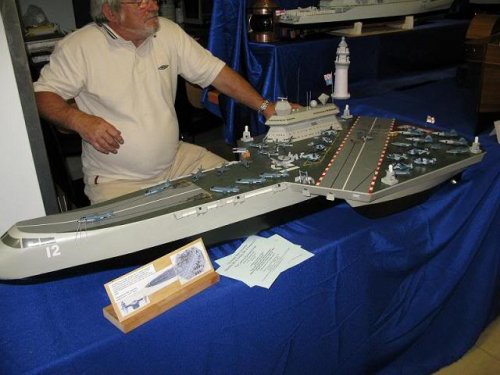
Is there nothing Avpro cannot do? Avpro designed Chuck Norris
Abraham Gubler
Triton said: Model of AvPro Stealth Trimaran Aircraft Carrier (STAC) on display at Model Boat Convention 09 (unofficial). Click to expand...
Abraham Gubler said: Great looking model but impossible to land an aircraft on. Click to expand...
- 18 February 2012
Triton said: Abraham Gubler said: Great looking model but impossible to land an aircraft on. Click to expand...
Triton said: Please elaborate, Abraham. Click to expand...
Thank you for the explanation, Abraham.
Similar threads
- Started by Mike Pryce
- 7 January 2007
- Replies: 55
- Started by overscan (PaulMM)
- 18 February 2008
- Started by A_Kid1234
- 17 November 2023
- Started by A Tentative Fleet Plan
- 27 March 2020
- Started by Brickmuppet
- 2 April 2008
- Replies: 123
Please donate to support the forum.
- This site uses cookies to help personalise content, tailor your experience and to keep you logged in if you register. By continuing to use this site, you are consenting to our use of cookies. Accept Learn more…

EDR Magazine
European Defence Review
- First Eagle Eye radar comes off the GA-ASI production line
- VOP Nováky Inaugurated a New Production Line for Ammunition Filling
- ► Hanwha Aerospace Completes Armoured Vehicle Factory in Australia
- ► Kongsberg to build missile factory in Australia
- ► Meprolight Strengthens Presence in India with New Assembly Line
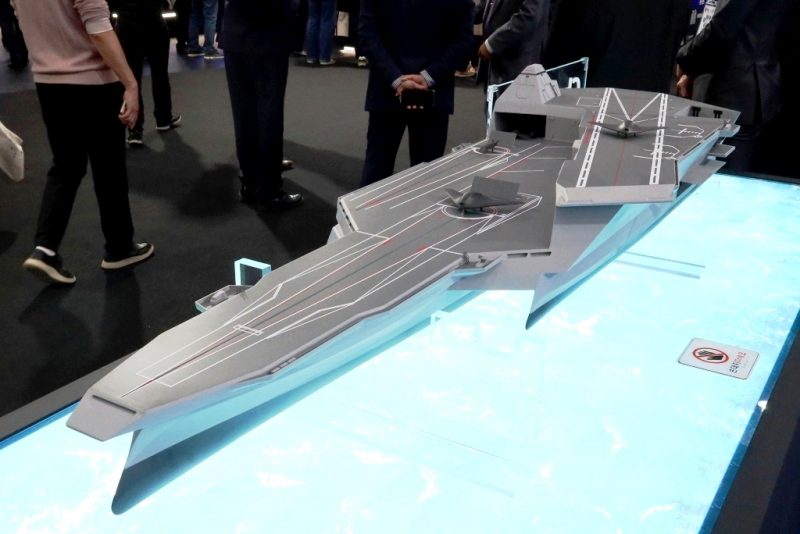
ADEX 2023 – Hanwha unveils an all-unmanned concept carrier
At adex 2023 hanwha exhibited the model of a concept ship, shown last june at madex, designed as an unmanned carrier, capable to deploy unmanned air, surface and underwater vehicles.
When visiting an Aerospace and Defense Exhibition, the spelling for ADEX, mostly oriented towards aviation and land equipment, writing on naval subjects might seem strange. But what is even stranger is the model exhibited by Hanwha, a futuristic approach to the unmanned naval world.
The “Ghost Commander”, the name says all, is a concept study that gave birth to two ship designs, a bigger one and a smaller one, that in perspective will allow an unmanned ship to deploy air, surface and subsurface unmanned assets to ensure a number of missions without putting at risk human crews.
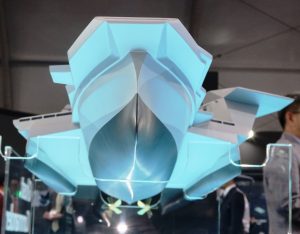
The bigger ship, which eye-catching model was exhibited at the Seoul event, is a 16,000 tonnes hybrid between a battleship and an aircraft carrier, with a length of 200 metres and a maximum speed of 25 knots. The trimaran hull is characterised by an inverted bow, all-electric propulsion being provided electric motors powered by hydrogen fuel cells, a two-pod solution being proposed, each with a five-blade propeller. The main flight deck is coaxial with the hull and runs along the whole ship, a takeoff runway being also coaxial while a second much shorter runway is located starboard, slightly angled to the right. Both are used only for take-off operations, as the stern superstructure does not allow landings. While the longer runway is used to launch bigger UAVs, the starboard one is reserved to smaller airframes.
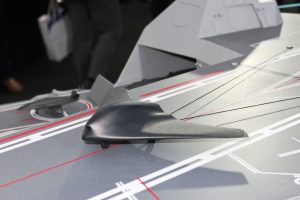
As for landing, a very short runway with arresting cable is located on top of the superstructure, angled left; an elevator on the port side allows to lower the landed UAV in the hangar where a robotic system will allow automatic turnaround operations to get the airframe ready for the next mission. On that same flight deck, on the port side, we could see the landing spots for vertical take-off and landing UAVs.
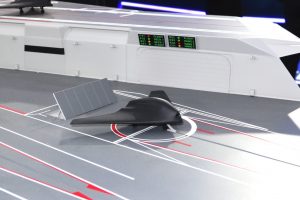
Being a concept ship many solutions might change, however catapult-assisted take off and arresting gear landings seem to be the current choice, although much will depend on UAV performances. Six long-range reconnaissance UAVs with a nearly fly wing configuration are hosted o the ship, the same number of shorter rage airframes being also embarked. For offensive and defensive purposes a total of 48 vertically launched systems, with a mix of loitering munitions and antidrone UAVs, compete the flight detachment.
Transversally to the ship, a rail system allows to carry unmanned surface vessels (USV) at the launch station, where a sort of cage takes the system and lowers it at sea. Two types of USV will be embarked, six specialised in reconnaissance missions, six other being multipurpose boats. No more details were available on USVs.
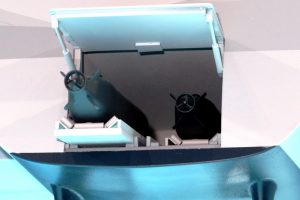
Another rail allows bringing astern unmanned underwater vehicles (UUV) to be launched. The ship hosts eight surveillance UUVs, also defined MRXUUVs, MR standing for multirole as they are reconfigurable according to the mission, that can be anti submarine warfare (ASuW) or mine warfare (MIW). Around 24 metres long, with a 3.0 metres diameter, it has a weight of around 50 tonnes. Propulsion is provided by a fuel cell air independent propulsion system and a lithium ion battery pack that powers the electric motor activating a ducted blade propeller that ensures an 8 knots maximum speed. It is fitted with flank array sonars and with a forward looking sonar. Free flooded rings complete its sensors suite, while a mine module allows it to be used for offensive or defensive mine operations. The MRXUUV is fitted with a hoistable mast that carries electro-optic sensors and antennas for surface and satellite communications.
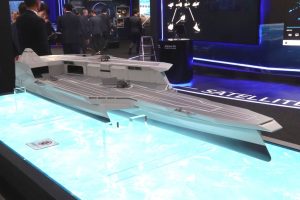
The ship also hosts three Combat XLLUVs. Its dimensions and weight are not very dissimilar from those of the MRXUUV, with a 2.5 metres diameter and a 23 metres length, weight remaining the same at 50 tonnes; only the maximum speed is considerably higher, up to 15 knots. Its stealth characteristics are improved thank to the low noise propeller, a minimal magnetic signature and the strict control on underwater radiated noise. It can be fitted with flank array sonar and multiple aperture sonar and can be armed with torpedoes and mines. It can be equipped with a mast dedicated to a LEO ( Low Earth Orbit ) satellite antenna as well as with a second mast for other equipment, for example electro-optic, both being foldable. The Combat XLLUV can be tasked for numerous missions, antisubmarine, antisurface, mine warfare as well as counter-mine operations.
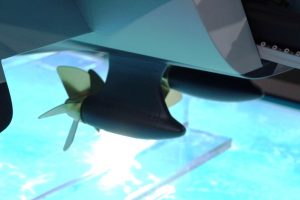
The smaller ship part of the Ghost Commander concept is also based on a trimaran hull and has a 5,000 tonnes displacement, is 130 metres long and can reach 25 knots, the propulsion plant remaining similar athough with a lesser power. Due to the central superstructure it has only a stern flight deck and therefore can only operate vertical take-off and landing UAVs. The ship carries four such UAVs, while a 24 cell system allows the vertical launch of loitering munitions and antidrone UAVs, half the load of the bigger ship. As for USVs and UUVs, the smaller ship capacity is for six each of the multirole assets. According to images provided in a presentation, the 5,000 tonnes ship will also be armed with a gun.
EDR On-Line understood that although the final target is to have a fully unmanned solution, intermediate steps might see the presence of a much reduced crew, awaiting some technologies to be fully developed. As for the timetable, a first prototype is foreseen in 10-15 years. And it might look pretty different from the model seen at ADEX, as concept studies tend to evolve pretty quickly.
Photos by P. Valpolini
- ← ADEX 2023 – Hyundai Rotem unveils its N-WAV 8×8 IFV prototype
- ADEX 2023 – KAI unveils its Combat Collaborative System →
Related posts
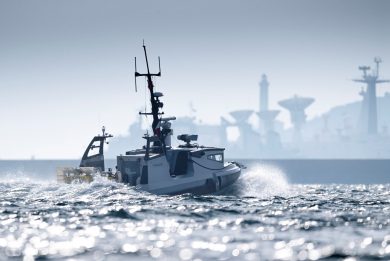
Thales’ uncrewed surface vessel passes a significant milestone in autonomous mine hunting trias
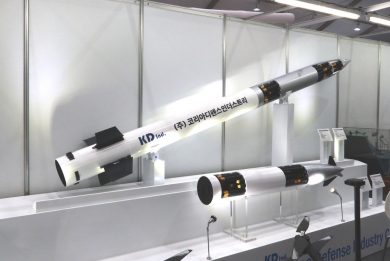
ADEX 2023 – Mass versus accuracy: KDI unveils a new unguided 230 mm rocket for the Chunmoo MRL
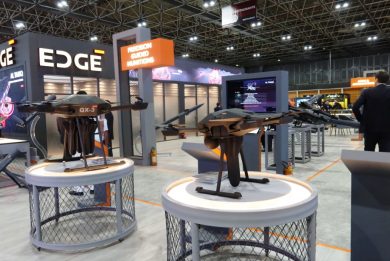
DEFEA 2023 – Edge looks at Greece in its move to expand its export footprint
Bremerton's Navy mothball fleet has a new ship: an experimental trimaran
BREMERTON — The newest member of the Navy's mothball fleet in Sinclair Inlet is an experimental trimaran decommissioned after a service life of just over a decade.
The USS Independence, a littoral combat ship, was praised by the Navy as helping inspire a new class of vessels that is more versatile in near-shore combat. But ultimately, Navy leaders felt the Independence's maintenance was too costly to keep it in service, opting instead to send it to Bremerton to the Naval Inactive Ship Maintenance Facility.
At the ship's decommissioning in San Diego on July 29 , Vice Adm. Roy Kitchener, commander of the Naval Surface Force for the Pacific Fleet, said the Independence served a specific purpose: "to test emerging equipment and concepts."
More: Navy eyes second aircraft carrier dry dock at Puget Sound Naval Shipyard
"Without (the crew's) efforts and experiences, the ship class would not be where it is today with six ships deployed throughout the world," he said.
The ship, pulled by a tugboat, is expected to arrive in Bremerton early Thursday morning.
Its purpose, along with three other vessels, was an "experimental platform" to build a better near-shore combat ship for the Navy, according to Brad Martin, a retired Navy captain and director of the Institute for Supply Chain Security at the RAND Corporation. The Independence's trimaran design of a main, central hull attached to two additional side hulls is "not like the V-shaped hull that people are used to seeing" in a Navy ship, he noted.
"They were essentially testbeds," Martin said of the Independence, along with the other early littoral combat ships USS Fort Worth, USS Coronado and USS Freedom, the latter of which is due to be decommissioned and come to Bremerton later this year.
While the Independence and Coronado are both trimarans built at Austal USA Shipyard in Alabama, the Fort Worth and Freedom are more traditional V-shaped hulls constructed at Marinette Marine in Wisconsin. The Navy has elected to keep building both designs. More than 30 of both kinds have been built.
More: New class of Navy frigates will be homeported at Naval Station Everett
Martin said the missions of the littoral combat ships included mine countermeasures and anti-submarine and surface ship warfare. The U.S. Naval Institute reported the vessels were built for a 25-year service life , but Navy leaders have prioritized funding for vessels like a new Constellation-class of frigates, the first 12 of which will be based in Everett .
Martin said the Navy had many "lessons learned" for the Independence, and "one hopes they assimilated them." They may have tried to jam too many concepts into one design, he said.
"Nobody likes to decommission a vessel after about 10 years but sometimes it's the right thing to do," Martin said.
The arrival at the mothball fleet in Bremerton doesn't spell the certain end of the vessel. It could conceivably be brought back into service, Martin said. But as more time goes by, it's more likely headed to the scrapyard.
The Independence is joining a number of other mothballed vessels here, including the former aircraft carrier USS Kitty Hawk , the ex-Bridge, a former supply-class fast combat support ship, the ex-Dubuque, an Austin-class amphibious transport dock, and the ex-Ingraham and ex-Rodney M. Davis, both Oliver Hazard Perry-class guided-missile frigates.
More: Former Kitty Hawk aircraft carrier leaves dry dock in Bremerton
There are also 11 de-fueled nuclear-powered vessels, including 10 submarines and one cruiser, the ex-Long Beach. The submarines awaiting dismantling include the ex-Philadelphia, ex-Dallas, ex-City of Corpus Christi, ex-Albuquerque, ex-Portsmouth, ex-Hyman G. Rickover, ex-Houston, ex-Norfolk, ex-Pittsburgh and ex-Miami.
Josh Farley is a reporter covering the military and health care for the Kitsap Sun. He can be reached at 360-792-9227, [email protected] or on Twitter at @joshfarley.

China’s New Super Carrier: How It Compares To The US Navy’s Ford Class
A new aircraft carrier, currently under construction in shanghai, is the most visible sign of china's rapidly expanding navy. it is larger than china's current two carriers and differs in key aspects. but the natural comparison is to the u.s. navy's latest carriers, the ford class..
H I Sutton 02 Jul 2021
Aircraft carriers are a strategic priority for the world’s leading navies. Experienced players such as the Royal Navy, French Navy (Marine Nationale) and Indian Navy are all in the process of bringing in new carriers. And Japan, South Korea and likely other countries are all taking steps to join the club. But nowhere is the capability gathering steam as much as in China. The Chinese Navy (PLAN) has already commissioned two carriers based on the Russian Admiral Kutzenov class. But their third carrier, known as Type-003 , promises to take the PLAN to the next level.
Meanwhile the U.S. Navy, for decades the world leader in this technology, is also modernizing with a new class of super carrier. The first Ford Class ship, USS Gerald R. Ford (CVN-78) was commissioned in 2017. While it has suffered some teething problems it remains the largest and most modern carrier afloat.
The Type-003 is very close in size to the U.S. Navy’s carriers. And although the definition is vague, it seems fair to also describe it as a “super carrier”.
Fresh commercial satellite imagery from Kompsat, via Shadowbreak Inti., allows us to finally measure the size and layout of the Type-003. This permits a general high-level comparison to the Ford Class.
The imagery shows that it is approximately 320 meters (1,050 feet) long. This is about 13 meters (43 feet) shorter than the Ford Class. And it seems less than it sounds if you placed the two ships side by side.
The Chinese ship does have a narrower flight deck however, It’s width of about 73 meters (240 feet) is very similar to preceding Type-001 and Type-002 carriers. There may be logistical reasons for this, such as dry dock sizes. Or it may simply be that the Chinese planners were happy with the width of the current carriers.
Going Electromagnetic
The major step change over the current carriers however is in how aircraft will be launched. The new ship is CATOBAR (Catapult Assisted Take-Off But Arrested Recovery) while the first two are STOBAR (Short Take-Off But Arrested Recovery). Like the Ford Class, the Type-003 is believed to use an Electromagnetic Aircraft Launch System (EMALS) instead of a steam catapult. This should promise a faster launch rate. This is a cutting edge technology which has reportedly been less reliable so far on the Ford Class, although things are improving . Yet despite its challenges it is still seen as the way forward and we should not assume that the Chinese will have the same problems. For China it is pragmatic to go straight to EMALS and miss the steam catapult step.
The Type-003 has three catapults with two on the bow and one in a waist position. This is one fewer than the Ford Class which, like earlier American carriers with steam catapults, also has four.
Catapults, which are lacking on the current Chinese carriers, will allow new aircraft types to be carried. A new fixed-wing airborne early warning & control aircraft (AEW&C), the KJ-600, is expected to be aboard. This is, both in role and overall form, very similar to the E-2D Advanced Hawkeye. Other new aircraft are expected to include a carrier version of the FC-31 stealth fighter. A full-size mock-up of this has recently appeared at a test site in Wuhan. This will be generally equivalent of the Ford Classes’ F-35C Lightning-II. It has twin engines however, and possibly a larger internal weapons bay.
It is likely that this new plane will take some time to enter service so the Type-003 may start operations with a catapult capable version of the J-15 Flanker.
Finally here a clear image of the full carrier including its installed island. (Image via Tieba) and thanks a lot to @raz_liu pic.twitter.com/orewwGVuz3 — @Rupprecht_A (@RupprechtDeino) June 30, 2021
Fewer Aircraft Elevators
The Ford Class has three aircraft elevators (lifts), one less than the preceding Nimitz Class. Despite this the combination of these and the ELAMS should provide a greater sortie rate than the Nimitz Class. The Chinese ship however has only two. These are both rectangular and on the starboard side of the flight deck. Possibly because of the larger island sits between them (unlike on the Ford Class where it is at the stern), the forward lift is very close to the catapults. The blast deflector is right next to it, not forward of it. This may limit its use while aircraft are taking off.
However, on paper the Chinese carrier should have a larger usable deck area thanks to fewer lifts. This may not be seen as a wise trade-off as it will take the Chinese longer to move aircraft up from the hangar. Actually the answer may lie in the Soviet legacy. The Type-003 appears to have inherited its twin lift arrangement directly from the Russian Admiral Kutzenov class.
The island of the Type-003 has only just been placed on the deck in the past few days. It appears shorter than the earlier Chinese carriers but retains their single-level control tower. Above it however will be large phased array radars. This is like the Ford Class.
To summarize, the Type-003 is slightly smaller in overall dimensions. It has fewer catapults and fewer aircraft elevators, which may reduce sortie rates. In general the American ship is a bold evolutionary leap based on decades of operational experience. The Chinese ship on the other hand is a much more conservative step forward from the less experienced carrier operator. There’s no denying that in overall terms the Type-003 is going to be a very large carrier which should be extremely potent. But it may be held back slightly by some design choices which are routed in Soviet thinking.
There are of course many details which we still cannot know about the Type-003. Or the Fords Class in some cases. But ultimately their combat effectiveness, if it ever comes to that, will partly be in the crew and doctrine. The PLAN lacks the vast experience of the U.S. Navy, but it is all the same rapidly gaining experience. it has been operating carriers for nearly 10 years and is clearly heavily invested in making them a success.
Related Articles

U.S. Navy commissions USS Kingsville (LCS 36)

No U.S. Navy Aircraft Carriers Deployed in the Pacific

Chinese Navy Testing Laser Turret On Type 071 LPD
- Defense Web TV
- Contact advertising
- Send Press Release
- Air Defense Vehicles
- Man-Portable Air Defense Systems
- Self-propelled anti-aircraft guns
- Anti-tank guided missiles
- Rocket launcher
- Tracked anti-tank vehicles
- Wheeled anti-tank vehicles
- Amphibious All-Terrain Vehicles
- Fire Support Vehicles
- Multi-Role Armored Vehicles
- Reconnaissance Vehicles
- Tank Destroyer
- Tracked APC vehicles
- Wheeled APC Vehicles
- Artillery Reconnaissance Vehicles
- Mortar Carrier
- Multiple Launch Rocket Systems
- Non Categories
- Radar Vehicles
- Self-propelled howitzers
- Towed Howitzer|Guns
- Command Post
- Communication Vehicles and Systems
- Electronic Warfare
- Armored Recovery Vehicles
- Bridge layer
- CBRN Vehicles
- Demining Vehicles
- Engineer Vehicles
- Mine Laying Systems
- Airborne Vehicles
- Tracked vehicles
- Wheeled Vehicles
- Amphibious Tanks
- Light Tanks
- Main Battle tanks
- Ballistic Missiles
- Cruise missiles
- Hypersonic Missiles
- ICBM Intercontinental ballistic missiles
- Tactical Missiles
- Light Tactical Vehicles
- Logistic Trucks
- Security Vehicles
- Air Defense Radars
- Counter battery radars
- Ground Radars
- Mobile Radar Systems
- Unmanned Aerial Vehicles
- Unmanned Ground Vehicles
- Assault rifles
- Field Equipment
- Grenade Launchers
- Machine Guns
- Sniper Rifles
- Sub-Machine Guns
- Turrets - Weapon Stations
- Aircraft carriers
- Amphibious Assault ship
- Amphibious transport dock
- Landing Craft
- Auxiliary ships
- Destroyers/Cruisers
- Naval Aircraft
- Naval Combat Equipment
- Patrol vessels
- Rigid Inflatable Boat
- Attack submarines
- Cruise missile submarines
- UAV (Unmanned Aerial Vehicles)
- USV (Unmanned Surface Vessels)
- UUV (Unmanned Underwater Vehicles)
- Automatic Cannons
- Close In Weapon System
- Civil aircraft
- Attack Helicopters
- Electronic Warfare Helicopters
- Transport Helicopters
- Command and control
- Electronic warfare
- Reconnaissance
- Trainer aircraft
- Transport aircraft
- Unmanned aircraft system
- Libya conflict day by day
- Operation Serval in Mali French Army
- Sangaris operation Central African Republic
- Sangaris opération militaire République Centreafrique
- Ukraine - Russia conflict
- Russia Ukraine War 2022
- HAMAS - Israel War 2023
- Syria conflict news
- Defence & Security Industry Technology
- Armies in the world
- Analysis Defense and Security Industry
- Naval Exercises
- Naval Technology
- Aviation defence industry technology
- Air Force in the world
Breaking news
- Leopard 2A5
- 7th Edition of NAVDEX 2023 to kick off with gre...
- IDEX & NAVDEX 2023 to showcase impressive exhib...
- NAVDEX will be the most largest Naval Exhibitio...
- NAVDEX 2023: BAE Systems displays Herne XLAUV
Please enable JavaScript

DSEI 2023: Hyundai Heavy Industries HHI unveils HCX-23 trimaran .
Amid the buzz and activity at the ongoing Defense and Security Equipment International (DSEI) 2023, Hyundai Heavy Industries (HHI) of South Korea has taken center stage with its latest naval innovation: the HCX-23 trimaran concept model. Follow Navy Recognition on Google News at this link
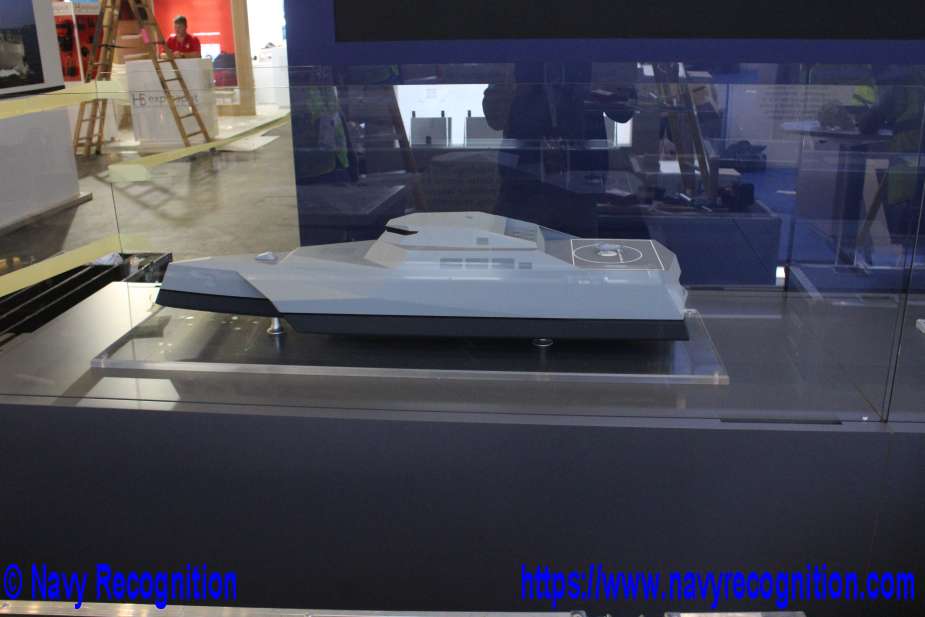
Previously showcased at the MADEX 2023 South Korean International Maritime Defense Industry Exhibition in Busan, this vessel is now drawing global attention.
The HCX-23 represents a significant leap in naval design with an emphasis on stealth. Its design incorporates a highly stealthy trimaran structure and a retractable radar system.
Notably, the rear of the bridge can accommodate multiple quadcopter drones. At the rear, there is a dedicated helicopter flight deck optimized for vertical take-off and landing (VTOL) operations. This deck is designed to host drones.
Beyond aerial capabilities, the HCX-23 is equipped for marine operations as well. Its stern features a specialized hatch that facilitates the launch and recovery of both unmanned surface vehicles (USVs) and unmanned underwater vehicles (UUVs). With the integration of two water-jet propulsion systems, the vessel stands as a testament to HHI's commitment to advancing naval mobility.
Technical Specifications for the HCX-23 include a length of 130 meters, a breadth of 36 meters, and a displacement of 6,000 tonnes. In terms of armament, the ship features a laser weapon naval gun and a KVLS-I/II type vertical launch system with 48 cells.
- Cookie policy
- Legal information

Choosing the right beam for a multihull
QUESTION: When assessing or designing a trimaran or catamaran, what guidance can you give to guide the choice of beam ?
Lech K: Gdansk, PL
ANSWER: An interesting question as we do see quite a variation on existing boats.
First, let’s call the Overall Beam to Length ratio B/L and the individual hull length to hull beam, L/b .
Here are a few basics to consider as inputs to your overall beam choice.
* More beam gives more transverse stability, permitting a powerful rig to drive a boat faster, but also, excessive beam tends to lower diagonal stability so increasing pitch-poling. More beam also tends to allow more fore & aft pitching.
* More beam requires stronger connecting beams (called akas on trimarans), aggravated by the two hulls potentially being now be in different waves
* More beam can be a problem in a marina where space is increasingly limited
* Folding trimarans can be limited in beam due to geometric space when folded, such as:
Transverse folding system (Farrier etc) are limited by how far down the hulls can be managed when folded.
Swing-arm folding is limited by the overall length increase when folded.
Hinge & latch systems are limited by what height and weight can be lifted
* Less beam allows a boat to heel more, thereby reducing sail exposure to side wind.
* Less beam brings the hulls closer together, reducing beam strength requirements and weight, but potentially adding to resistance from hull-flow interaction.
* Hulls with a high L/b ratio can be closer together than hulls with a low L/b ratio if overall stability permits.
* As smaller boats need proportionally more displacement due to crew and structural weight, they cannot have a very high L/b ratio as they then have insufficient displacement.
------------------------------------------------------------------------------------------------------------------------------
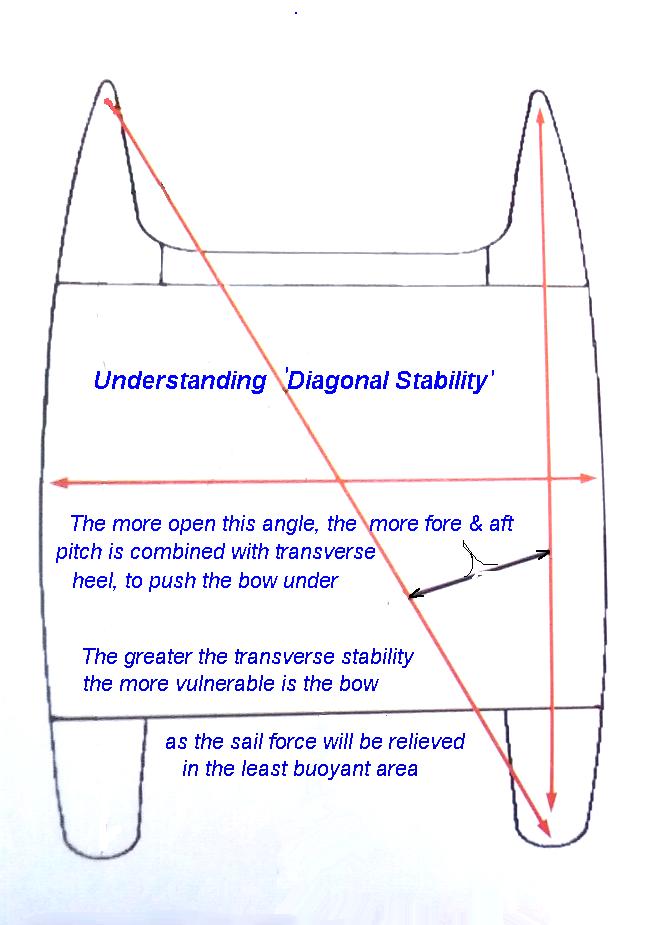
So what do all these points finally lead to ? Well, let’s see.
For Catamarans , the sweet spot seems to be with a L/B of 2 to 2.1.
If the beam is excessively increased, pitching and reduced diagonal stability (see dwg) start to become an issue and when such boats are lengthened to make their L/B slightly above 2, they generally become faster and have less negative issues ... but over about 2.3, their relatively lower transverse stability then starts to kick back.
If the beam is decreased, stability drops quickly and one may start to also add wave interference between the hulls unless the boat is very light with slim hulls.
Of course, this is a simplification of things as top weight, windage, wing clearance, center of gravity, sail plan, etc etc .. all have their effects, though individually less than the important L/B ratio.
Let me give you an example of how other design criteria can move things from what may initially seem the ideal.
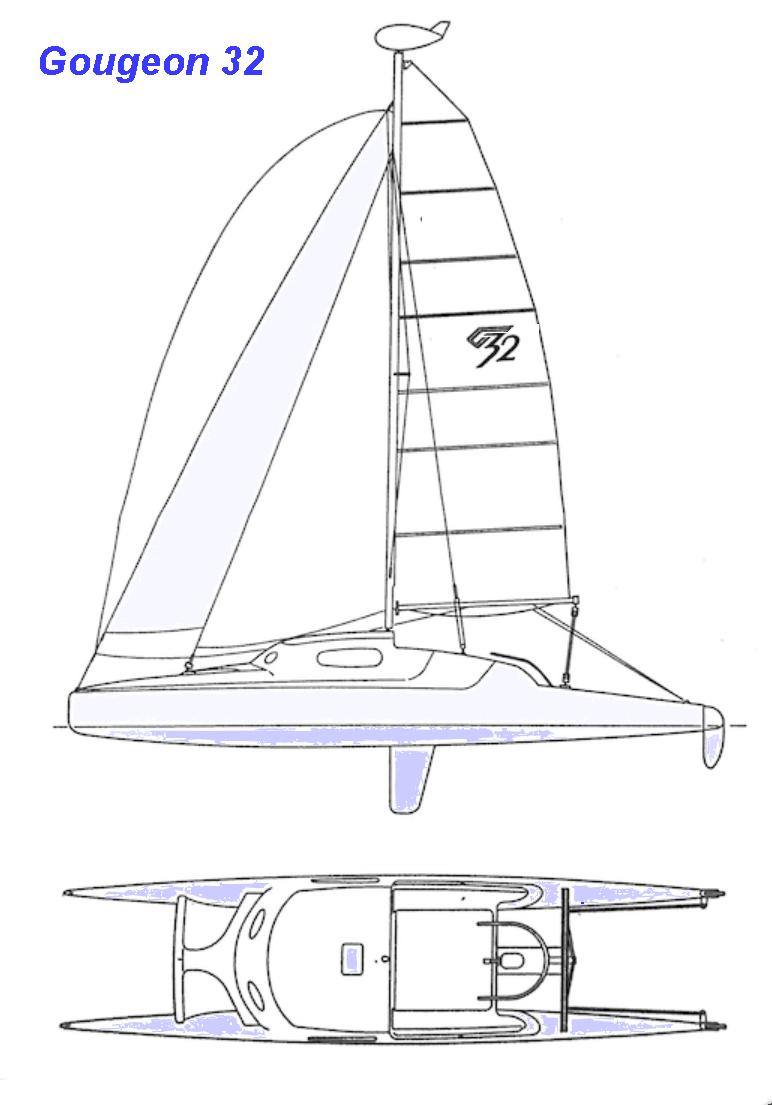
Beam also has a huge effect on stability. But the designer Jan Gougeon (then of West Systems) was an inventive guy, so he approached this design in a non-conventional way. To achieve his first criteria .. “a fast non demountable weekend catamaran”, he needed to address the obvious lack of stability in other ways. A low rig could work with low weight, that would then allow very slim, fast hulls. Then he added water ballast to help keep the windward side down …. and finally, a masthead float to prevent the boat from turning turtle, where she would stay like virtually all other multihulls do IF that happens. In this case, it was rather often as unfortunately, most sailors were not ready to adapt to this new way of sailing and with capsizes happening too quickly for most, only a dozen or so were sold. But I did get to try the boat and felt the concept did work in the sense that the boat IS fast and also comfortable & dry, as with such long, narrow hulls, there is very little disturbance of the surface water so spray is minimal and even if the hulls are pretty close, they are too slim to create any significant cross-hull wake- interference.
To keep the rig low (mast is shorter than the boat), she uses 2 foresails that can be furled up fast. Those that still own one have learned to understand them and can enjoy their merits … but this is not a boat with reserve stability for sudden gusts, so you need to sail this boat more like a race dinghy and also reduce sail early. This further means that sailing at night when you cannot see squall warnings in the sky is best avoided unless the stars are truly out for you.
But it IS an example of thinking WAY outside the box .. even if the result is not for everyone. So ‘sweetspot L/B ratios’ do not necessarily mean they give the only solution .. just that you, as a designer, also need to work differently around the rest of the design to solve the issues you might create if you are well outside the norm.
The lesson here is: If you choose to go outside the norm, fully understand the implications and work around them. You cannot ignore them and still expect success. If the designer failed at all with this radical G32 design, it was in not sufficiently educating new owners of the different sailing nuances needed to keep the boat on its feet.
For Trimarans, my studies and observations show that the preferred B/L ratio changes with boat size.
To some degree, the same effect on diagonal stability (as for Cats) will occur with excessive beam, but with a trimaran, the two hulls in the water will be closer so it’s also important to allow for good flow between them. So as very large racing tris can have slimmer hulls due to great length and low weight, they can have proportionally lower B/L ratios than smaller boats that need proportionally fatter central hulls just to support the displacement they need. After all, we cannot just change things in proportion, because the weight of things (such as crew, structure etc) will not automatically get smaller for a smaller boat .. in fact it proportionally and typically, gets greater! So smaller multihulls can often be harder to design than larger ones, where you have more space and volume to work with. The above observations led me to plot data from good boats and create this simple little formula that fits their B/L curve pretty well.
Here is what the curve gives as a recommended B/L ratio for a sailing trimaran
(Sailing Trimaran) B/L ratio = 1.48 ÷ (L ^ 0.21) [ Length L in feet ].
While this may initially look complex to calculate for some, it’s very easy with the right help. Download the Mobi Calculator on your phone or tablet. You can then add the expression x n to your basic calculator by first hitting the 3 dots [ ... ] that brings you to the Scientific Options, and then clicking on [ x n ] that will add this feature to your basic calculator. You can now enter the formula exactly as written, typing 1.48 ÷ ( your L value , and then x n and finally 0.21 and the closing bracket ) and then ‘ = ‘.
If you enter say L = 17 , it will give you a B/L ratio of 0.816, closely matching a W17 , while for an L of 100 ft, it will give you a B/L of only 0.562, closely matching a big ocean racing tri like Sodeb’O.
While of course you can go outside the calculated ratio, IMHO you should have a very good reason and specific justification for a deviation of more than 15% either way. Use the list at the beginning of this article to justify your change.
For both Tris and Cats, there may be other factors that will change your design, but this gives a good starting and target point that’s based on both practical and justified design needs.
Enjoy …. playing with figures is fun ;)
mike … march 2022
ADDED NOTE ... re MOTOR MULTIS
As noted, the above ratios refer to Sailing Craft. Without the heeling force of a sail, pure motor-tris and cats are not bound by the same needs.
A motor catamaran can have less beam, with a clean flow between the hulls now taking prominence over high beam for sailing stability, so L/B ratios of 2.5 to 3 are now more appropriate.
Hulls may need to be asymmetrical with a straighter side on the inside to avoid unfavorable hull wave interaction between them.
For a powered trimaran , overall beam should also be reduced or the motion will become uncomfortable. (With a sailing tri, the boat is heeled with one ama out, but with a motor tri, all three hulls are immersed so wave action on the boat would be too severe if the boat is too wide) . Amas (pontoons) now need to be narrow but deep, as a slow gentle roll of slightly greater amplitude, is more comfortable than a short quick one. These amas (now only 40-50% of the main hull length), seem best with their center about 60-70% aft of the main hull length and need to be of fine section and relatively deep with the connecting bridge arched high above any waves, so that neither ama or aka-bridge will slam when re-entering a wave. L/b ratios of all 3 hulls can be at their most efficient, namely 13-16 at the waterline. The amas are now more like permanent training wheels and with a much longer central hull and no heeling force from sails, diagonal stability is no longer something to consider. Overall beam will depend on maintaining a clean flow between the main hull and the shorter slim amas, that need to extend well down into the water, so that motion is acceptable in waves. Typical overall B/L ratios might now be down around 0.4, becoming even less as boat design gets bigger, provided the center of gravity is kept low.
"New articles, comments and references will be added periodically as new questions are answered and other info comes in relative to this subject, so you're invited to revisit and participate." —webmaster
"See the Copyright Information & Legal Disclaimer page for copyright info and use of ANY part of this text or article"

Latest Forum Topics
- American Politics: Machine Guns for H… (2,715)
- Using the AN's flag, how do they deal… (7,891)
- Based on AN flag, what do they export… (272)
- AN as a car? (85)
- Guess AN's Gender (3,452)
Advertisement

Dispatch → Account → Military
Commonwealth defence - 'phoenix-t' trimaran aircraft carrier.

- New threadmarks
Follow along with the video below to see how to install our site as a web app on your home screen.
Note: This feature may not be available in some browsers.
- This year's penultimate batch of new Awards has arrived. Introducing the Informative Award and the Jaw Drop Award!
- The Real World
- The War Room
Catamaran Aircraft Carrier
- Thread starter sanman
- Start date Feb 28, 2009
- Feb 28, 2009
1 Carrier for the price of 2?
From NERV's Heart I Stab At Thee
How many hits in the central section would it take to turn that into two separate hulls?
Klingon Warrior
TheSandman said: How many hits in the central section would it take to turn that into two separate hulls? Click to expand... Click to shrink...
Bishop Gantry
General edmund duke.
So two supertankers with an airfield bolted onto the middle?
Major Diarrhia
It could easily be too flimsy in the middle to be practical. You also might not be able to have a single hanger deck.
You could make it thicker in the middle. Hell, just build more decks on top to make it higher. But this way you'd have more deck space for launch runways and to park aircraft. We've all seen pics where some carrier aircraft have to be able to fold their wings for more compact storage, because space is at a premium. I'm wondering how much is compromised on combat-worthiness to allow for the folding, etc? More equipment and supplies can be carried aboard. Having 2 launch runways and sets of catapults instead of just the one allows for more redundancy. Maybe it could be powered by dual reactors, instead of just one. So one reactor for each side would allow for independence and redundancy. If one side was bombed or hit, the other side could keep functioning unaffected. The reactor on one side could be shut down if necessary, whether because of damage or because of maintenance, while the other reactor remained online to provide power for the entire ship. On the underside of the central section, you could have loading doors with cranes and hoists that could pull in heavy cargo from below, or deploy sea launch craft. A large central area would also allow you to have a much larger island.
AdmiralTigercla
Naughty bracket and fire for effect..
When you're talking about something the size of a CARRIER, Catamaran design doesn't really do much for it anymore. It's already so BIG that it's pretty much stable in all but the worst weather conditions. And you're NOT launching off a carrier deck in a typhoon.
bookmonkey786
2 hangers might be an advantage though. One side gets taken out the other side can still support aircrafts.
Librarian- the original search engine
In that case you may as well have 2 conventional aircraft carriers- one goes down there is still the other one, with the added benefit that if one is hit the other isn't adversely affected by the damage (you are all assuming that damage to one side of the catamaran won affect the other) EDIT: IIRC wasn't one of the contenders for the RN's last Carrier proposal a trimaran? I'll have to dig out the concept sketch files.
Major Major
Nemo me impune lacessit.
Basically Naval Ops: Warship Gunner 2 , huh?
Horrible Cat
Man, most of the posts in this thread are like "TWO hulls? How absurd! *monocle flies off*" as though catamarans have never been successfully built.
Inquisitor Kard
Once inquisitor ryan.
AdmiralTigercla said: When you're talking about something the size of a CARRIER, Catamaran design doesn't really do much for it anymore. It's already so BIG that it's pretty much stable in all but the worst weather conditions. And you're NOT launching off a carrier deck in a typhoon. Click to expand... Click to shrink...
Ralson said: Man, most of the posts in this thread are like "TWO hulls? How absurd! *monocle flies off*" as though catamarans have never been successfully built. Click to expand... Click to shrink...
Commander 598
Tailhook representative.
Inquisitor Ryan said: ...last I checked the Military IS investigating using Catamaran and Trimaran hulls with next-gen warships. Click to expand... Click to shrink...
(Above) Another futuristic CVF design destined never to see the light of day - the Stealth Trimaran Aircraft Carrier (STAC). Click to expand... Click to shrink...
Dark Schtroumpf
Commander 598 said: You're behind on info then... Edit: Oh and I managed to dig up something on a prospective UK trimaran carrier: Click to expand... Click to shrink...
"Repent & rejoice. For we are your betters, peon"
I think what some people are forgetting, at least for the USN and most other navies, there are things that limit the size of warships. The Panama Canal, which is the limit for which a USN ship can be built, it has to be able to go through the canal, Nimitz class carriers are already pretty much the largest you can build a carrier and still make it through that canal. So a catamaran carrier doesn't give you anything, as the carrier now can no longer transit that canal, and has to travel all the way around South America to go from the Pacific to the Atlantic or vice versa, not something you want, as it limits your ability to move your forces. So yeah, catamaran carriers: Useless
SuperS4 said: I think what some people are forgetting, at least for the USN and most other navies, there are things that limit the size of warships. The Panama Canal, which is the limit for which a USN ship can be built, it has to be able to go through the canal, Nimitz class carriers are already pretty much the largest you can build a carrier and still make it through that canal. So a catamaran carrier doesn't give you anything, as the carrier now can no longer transit that canal, and has to travel all the way around South America to go from the Pacific to the Atlantic or vice versa, not something you want, as it limits your ability to move your forces. So yeah, catamaran carriers: Useless Click to expand... Click to shrink...
last I checked the Military IS investigating Click to expand... Click to shrink...
Sean21 said: Like was said, super carriers(at least the highest point of their beams) can't pass through anyways. They wouldn't be totally useless; just have them operate in certain theatres. Click to expand... Click to shrink...
SuperS4 said: Sorry, was getting a bit ahead of myself, the Panama Canal is set to be expanded, allowing Nimitz class sized craft to go through. Any Catamaran carrier however, will be too big. If not too big, then there is no point in making a catamaran class carrier. Also, unlike the USN which have enough carriers to not really care(again, sorry for jumping the gun with the Nimitz thing), most nations don't have this option. So if they're making a carrier, they'll likely want to be able to get it around the world without having to take a longer trip then necessary, and like I said, catamarans won't be fitting through even the expanded Panama Canal, because if they do, you may as well have built a conventional carrier, it would be cheaper. Click to expand... Click to shrink...
SuperS4 said: Sorry, was getting a bit ahead of myself, the Panama Canal is set to be expanded, allowing Nimitz class sized craft to go through. Any Catamaran carrier however, will be too big. If not too big, then there is no point in making a catamaran class carrier. Click to expand... Click to shrink...
Also, unlike the USN which have enough carriers to not really care(again, sorry for jumping the gun with the Nimitz thing), most nations don't have this option. So if they're making a carrier, Click to expand... Click to shrink...
they'll likely want to be able to get it around the world without having to take a longer trip then necessary, and like I said, catamarans won't be fitting through even the expanded Panama Canal, because if they do, you may as well have built a conventional carrier, it would be cheaper. Click to expand... Click to shrink...
- Mar 1, 2009
Ralson said: If? The Charles de Gaulle cannot fit through the canal, to my knowledge. ? Click to expand... Click to shrink...
672 Wine Club
- Motorcycles
- Car of the Month
- Destinations
- Men’s Fashion
- Watch Collector
- Art & Collectibles
- Vacation Homes
- Celebrity Homes
- New Construction
- Home Design
- Electronics
- Fine Dining
- Benchmark Wines
- Brian Fox Art
- Chase United
- Disneyland Resort
- Gateway Bronco
- Royal Salute
- Sports & Leisure
- Health & Wellness
- Best of the Best
- The Ultimate Gift Guide
The 10 Best Superyacht Concepts of 2023
Blue-sky superyacht concepts range from pure fantasy to easily buildable. here are our 10 favorites in the last year., howard walker, howard walker's most recent stories.
- These Slim New Catamarans Are Redefining the Category. Here’s How.
- First Drive: This Modern Pickup Truck Packs a Nostalgic Punch
- Meet the Bugatti Tourbillon, the 1,800 HP Hybrid Hypercar Replacing the Chiron
- Share This Article

To stand out from the crowd, more and more superyacht buyers—many new to the market—are challenging designers to break molds, go extreme, and think way outside of the traditional box. And they’re doing it with head-spinning bow designs, huge windows, and much larger interior and exterior spaces.
They’re also trading traditional monohulls for big-volume catamarans and trimarans, taking inspiration from oddball places—an aircraft carrier or 1930s Hollywood-style automobile—and, at the same time, future-proofing them with new propulsion systems, including hydrogen fuel cells, solar power, and advanced battery power.
These 10 concepts, from a range of designers and studios, show that the future of superyacht design has never been more exciting—if at times a little bizarre.
Sinot, ‘Aware’

Not all superyachts need to look like multi-tiered wedding cakes. That’s according to Dutch studio Sinot Yacht, which has just penned conceptual renderings for a sleek, almost-minimalist cruiser called Aware . Yes, the 262-footer does have the look of some super-stylish European river boat from the likes of Viking or Uniworld. But the aim here is to optimize the spaces experienced owners tend to use the most. Like the owner’s suite on the main deck, which in Aware spans the full beam and totals over 860 square feet. Then there’s the super-size beach club with its twin fold-out terraces, gym, bar, cinema, 36-foot-long pool, and glass-sided dining area. As for power, Sinot envisions a hybrid diesel-electric propulsion system good for a 21 mph max, and a 4,000 nautical mile range at 14 mph.
Icon Yachts, ‘Mission’
Ice-breaking, globe-trotting expedition yachts are nothing new for Holland’s Icon Yachts. Its rugged, 224-foot, converted ice-breaker Ragnar literally wrote the rule-book on building high-latitude-friendly luxury superyachts. But Icon’s concept for a brand-new, ultimate explorer it’s calling Mission adds Indiana Jones–levels of off-the-grid exploration. Designed by Dutch explorer-yacht specialist Bernd Weel, Mission is all towering, ice-crushing bow, trademark geometric hull sides, and endless space for all that adventure-seeking gear. Here we’re talking six tenders of all sizes, a three-person submersible, an Airbus H130 helicopter, and space midships for a multitude of shipping containers for when you want to become the next Jacques Cousteau. As for range, Icon would target over 6,000 nautical miles.
Andy Waugh Yacht Design, ‘Decadence’

Flick through the pages of any automotive history book and you’ll notice that 1930s design is dominated by the outrageous, teardrop-fendered creations of the French duo of Figoni et Falaschi. Their designs look to be the inspiration behind London-based designer Andy Waugh’s jaw-dropping concept for a 264-foot catamaran he quite aptly calls Decadence . Featuring a central hull flanked by four teardrop-like pods, the concept evolves the idea of so-called SWATH catamaran hull design used in a number of oil-platform support, research vessels, and even some superyachts. Providing immense stability through reduced roll and pitch, the design makes perfect sense for a superyacht. One drawback: the yacht’s massive, marina-unfriendly 98-foot beam. Though that becomes a positive when you consider Decadence ‘s vast owner’s suite measures 66 feet wide and almost 100 feet long.
Oceanco, ‘Aeolus’

When the Dutch superyacht maestros at Oceanco release a blue-sky design, the concept is likely just a few steps away from reality. Fresh from delivering the 410-foot Koru , the world’s largest sailing yacht, to new owner Jeff Bezos, and the 357-foot Seven Seas to Steven Spielberg, Oceanco has unveiled Aeolus , a concept for a highly sustainable 430-foot gigayacht. Drawn by former Rolls-Royce head of design Giles Taylor, this curvaceous, quad-deck world cruiser looks to the future by incorporating Oceanco’s Energy Transition Platform (ETP) philosophy. The propulsion could start with diesel-electric power, with battery banks charged by twin MTU V16 diesel generators. Then, as technologies advance, it could more to more advanced fuel types such as methanol or other, even wilder technologies like nuclear power.
Anthony Glasson, ‘Star Trek’

Designed to boldly go across oceans, this concept for a massive 275-foot trimaran i s said to have been inspired by Hong Kong–based designer Anthony Glasson’s love of the TV show “Star Trek”—especially the Starship Enterprise . Viewed bow-on, you can see why: The slender, wave-piercing bow, the twin side hulls, and rounded glass upper observation deck have USS Enterprise written all over it. But the trimaran form definitely adds to its function, with the wide beam creating an expansive “courtyard” that’s part enclosed and part open, housing a hot tub—one of three aboard—a gym, a bar, sunpads galore and even a helipad-turned-dancefloor. Glasson envisions the trimaran to be built of lightweight aluminum, with a 5,000-nautical-mile range. Captain Kirk would be impressed.
Jozeph Forakis, ‘Pegasus’

Until now, arguably the ultimate stealth boat was the one in the 1997 James Bond romp Tomorrow Never Dies , owned by tyrannical media mogul Elliot Carver. That would change if the 289-foot concept Pegasus , from the computer screen of N.Y.C.-born and now Milan-based designer Jozeph Forakis, gets a production go-ahead. It features a superstructure comprising three over-lapping “wings” with metallic surfaces designed to reflect the sky and the clouds, rendering the superyacht near-invisible. The “wings” also do double duty as solar panels generating energy that would be used to convert sea water to hydrogen. Fuel cells would then turn the hydrogen into electricity that would be then stored in banks of lithium-ion batteries, making Pegasus essentially emissions-free with a virtually infinite cruising range.
Lazzarini, ‘Plectrum’

Why fly through the water when you can fly on top? That’s the thinking behind Rome-based Lazzarini Design’s radical 243-foot hydrofoiling superyacht concept named Plectrum . Massive foils deploy from the sides of the yacht’s rounded carbon-fiber hull, while a trio of 5,000 hp engines would elevate the yacht out of the water and punch it to a top speed of over 80 mph. It’s a similar concept used in the latest America’s Cup AC75 foiling monohull sailboats, along with a crop of electric powerboats and surfboards. Applying the technology to a 243-foot superyacht is what’s new and possibly technically impossible, at least for now. Other stand-out features of this bright-orange flyer include a helicopter garage beneath the mile-long foredeck and a garage for your supercar at the stern.
Phantom and Golden Yachts, ‘Vesper’

When it comes to next-generation superyacht design, it seems glass is fast becoming the new steel. Take the collaboration between the design team at Holland’s Phantom Studios and Athens-based superyacht builder Golden Yachts. The 213-foot concept they’re calling Vesper features five levels of floor-to-ceiling structural glass, a glass floor in the yacht’s upper deck lounge, and a glass-sided swimming pool. Connecting the beach club to the pool is a huge, high-lifting hatch that’s, what else, all glass. Now head to the owner’s “suite”—it’s more like a two-level penthouse in a Miami skyscraper—and it features floor-to-very-high-ceiling glass that floods the space with light. To catch some real rays, the full-deck suite features not one, but two outdoor terraces.
DeBasto Design, MED

Think of this as a 301-foot dayboat with the emphasis on outdoor, alfresco, lounge-in-the-sun, Mediterranean living. From the drawing board of Miami-based designer Luiz de Basto, Project MED features uninterrupted, bow-to-stern open teak decks topped with a huge upper superstructure supported by just four columns. And to ensure the superstructure doesn’t dominate the superyacht’s sleek lines, de Basto covered it in reflective glass so that it almost disappears from view by mirroring its surroundings. The designer says his inspiration came from the idea of “Agora,” named after the squares in Ancient Greek villages where everyone congregated. Aboard Project MED, that could be on the main deck, around the oversized pool at the stern, or on the vast open foredeck.
Enzo Manca, ‘UAE One’

There are superyachts designed to look like military warships. Some even are shaped to look like navy submarines. But here’s a first; a superyacht inspired by the lines of an aircraft carrier. The 459-foot UAE One is from the fertile mind of Milan-based designer Enzo Manca who created the concept for an unnamed United Arab Emirates sheikh looking to create an official UAE flagship. Without a doubt, the design highlight is the yacht’s runway-like main deck. It features not one, but three helipads, a conning tower-like, four-level structure on the starboard side, a geometric-shaped pool and a huge circular “conversation pit” right on the bow, complete with cozy sofas and a firepit. Accommodations over nine decks include five “super suites”, eight master cabins, 14 mini apartments, and 35 cabins for the crew of 65.
Read More On:
- Superyacht Design
- Superyachts
More Marine

New Zealand’s Thrilling Win Gets the America’s Cup Off to a Rip-Roaring Start

This Revamped 161-Foot Trinity Superyacht Could Be Yours for $16 Million

Rescuers Find Remaining Missing Aboard the Sunken ‘Bayesian’ Superyacht

Tech Mogul Mike Lynch and 5 Others Are Missing After a Yacht Sinks in Italy

Meet the Wine Club That Thinks Differently.
Receive editor-curated reds from boutique California producers four times a year.
Give the Gift of Luxury
Latest Galleries in Marine

6 Electric Surfboards That’ll Help You Ride the New E-Foil Wave

‘La Dea II’ Superyacht in Photos
More from our brands, queen maxima of the netherlands brings tropical flair in green colorways and flowy trousers to formula 1 dutch grand prix, u.s. open cash spigot flows as usta turns to investments, oasis streams surge globally on spotify amid reunion rumors, love, melancholy, anger, and surprise: asian artists explore the emotional side of ai, the best yoga mats for any practice, according to instructors.

Farrier International
a Division of Daedalus

The F-82 superseded the original F-25A trailerable yacht for home builders, and comes in two versions:
F-82A a lower powered version for cruisers and can be built with either wood or foam strip planking
F-82R – a higher powered version for racers, and the direct equivalent to the F-25C – one of the fastest multihulls of its size in the world. The F-82R must be built in foam, for the lightest possible weight.
Both design versions offer excellent all round performance for those who want a fast cruising multihull with a cruiser friendly roomy interior.
The F-82’s cockpit will seat six, and is large enough for outdoor sleeping on summer nights. Further aft is a large swim step platform area which allows easy on and off access.
Interior is very roomy, with more headroom and a longer cabin compared to original F-25A. Different interior layouts are possible, with an optional enclosed head, while galley can be at either fwd. or aft end of cabin to suit sleeping requirements. An aft cabin option is now also available.
Both cabin settees are wide and can form two very comfortable permanent quarter berths. Forward is a large double berth, with a huge storage area underneath.
There is standing headroom under the large and unique combination pop-top. This can slide forward for quick cabin access, have the aft end only lifted to act as a dodger, or lift completely up to considerably increase comfort and room below. Sides can be fully enclosed/screened.

Mast is an aluminum or carbon fiber rotating wing section, and mainsail can be boomed or boomless. A retractable ‘free standing’ bow pole (no side stays required) is used for the asymmetric spinnaker, for convenience and easy handling.
Daggerboard or centerboard are optional, as are a kick-up spade rudder or a transom mounted rudder. An outboard of 4 to 8 HP is recommended and this is mounted on the stern.
Construction can be strip planked foam, cedar or Durakore™
F-82A™ Specifications
| L.O.A. | 26′ 11″ (8.2m) |
| L.W.L. | 24′ 6″ (7.46m) |
| B.O.A. | 19′ 6″(5.95m) |
| Folded Beam | 8′ 2 1/2″ (2.5m) |
| Draft | 1′ (0.3m) |
| D/board down | 4′ 7″ (1.4m) |
| Mast height | 34′ (10.6m) |
| Sail Area (Main & jib) | 408sq.ft. (37.8sq.m) |
| Height on Trailer | 9′ 8″ (2.95m) |
| Empty weight | 1500 – 2200lbs (680 – 1000kg) |
| (depends on materials/methods) |

F-82R™ Specifications
| L.O.A. | 26′ 11″ (8.2m) |
| L.W.L. | 24′ 6″ (7.46m) |
| B.O.A. | 19′ 6″(5.95m) |
| Folded Beam | 8′ 2 1/2″ (2.5m) |
| Draft | 1′ (0.3m) |
| D/board down | 4′ 7″ (1.4m) |
| Mast height | 36′ (11m) |
| Sail Area (Main & jib) | 430sq.ft. (39.8sq.m) |
| Height on Trailer | 9′ 8″ (2.95m) |
| Empty weight | 1500 – 1800lbs (680 – 820kg) |
| (depends on materials/methods) |

Below is Dean Snow’s F-82R ‘Redshift” which took line honors in the 1998 Williamstown (Melbourne) to Geelong race in Australia, as part of the “Scotchman’s Hill Festival of Sail” (Australia’s largest keelboat regatta). ‘Redshift’ led home a fleet of around 200 boats in 5 hours and 14 minutes, 30 minutes ahead of the Grainger 42′ racing trimaran ‘Spirit of Emu’.
‘Redshift’ then went on to easily take line honors in the 1998 Marlay Point Race, Australia’s largest race for trailer yachts (can be up to 600 boats). Second over the line was Greg Kay’s F-28R (seen behind ‘Redshift’), which was 1st overall on corrected time. Third over the line was an F-24 Mk II, fourth an F-25A, with another F-25A fifth.
‘Redshift’ took around 1500 hours to build, and material cost was approximately A$38,000 (US$24,000). ‘Redshift’ was sold for over A$80,000, and Dean has since built an F-9R.


IMAGES
COMMENTS
Another Drone Carrier Warship Variant: The Naval Group's "Ocean Avenger" Naval Group's "Ocean Avenger" Drone Carrier Warship is a trimaran design that carries a 155mm gun and several banks of VLS tubes. The three hulls allow for two straight runways and a rotorcraft spot at the stern.
The Chinese trimaran frigate will be about 465 feet long, and has a beam of 105 feet and a weight of 2,450 tons. Interestingly, it may be the first Chinese warship to use an integrated electrical ...
Booooo. Because catamarans don't make a ton of sense for aircraft carriers. The advantage to a catamaran is that you can achieve very high fineness ratio without sacrificing stability, by splitting your displacement into two narrow hulls connected by a common beam. The thing is, the entire point to an aircraft carrier is displacement.
Olsen, S.A., the Benchijigua operates long, arduous routes around the Canary Islands. Austal are now approaching completion of their next generation trimaran, the Auto Express 102. Now in week 18 ...
The section on the "Stealth Trimaran Aircraft Carrier" gives a few more details. The diagonal flight deck is said to be 450 ft (130m) long, which makes the overall length about 920 ft (280m). Displacement was reported as approximately 40,000 tonnes, with a capacity of 55 aircraft.
Russia's light aircraft carrier will feature a semi-catamaran hull, a representative of the Krylov Scientific Center told Russian news agency TASS (see the translation and a model of the design here).
The collective gasp by onlookers as the massive tri emerged from the aircraft hangar-sized building shed at the Multiplast works in Vannes, France, said it all—the new Sodebo instantly made every other high-tech trimaran look like yesterday's boat. Measuring 104ft long by 75ft wide, the boat covers the area of four tennis courts, but it's the radical design elements that draw the eye.
Impossible Engineering | Thursdays at 9/8cThe new Littoral Combat Ships like the USS Independence use a trimaran design for greater speed, agility, and stabi...
At ADEX 2023 Hanwha exhibited the model of a concept ship, shown last June at MADEX, designed as an unmanned carrier, capable to deploy unmanned air, surface and underwater vehicles ... The trimaran hull is characterised by an inverted bow, all-electric propulsion being provided electric motors powered by hydrogen fuel cells, a two-pod solution ...
With a defence heritage that stretches from WWII to the ground-breaking design for the new UK aircraft carrier, we operate globally, delivering complex digital, engineering and strategy consulting. ... so not only the drag is reduced, but the sea keeping characteristics are improved. Compared to a trimaran hull form, lateral accelerations are ...
About Press Copyright Contact us Creators Advertise Developers Terms Privacy Policy & Safety How YouTube works Test new features NFL Sunday Ticket Press Copyright ...
The Independence class is a class of littoral combat ships built for the United States Navy.. The hull design evolved from a project at Austal to design a high speed, 40-knot-cruise ship. That hull design evolved into the high-speed trimaran ferry HSC Benchijigua Express and the Independence class was then proposed by General Dynamics and Austal as a contender for Navy plans to build a fleet ...
0:02. 1:40. BREMERTON — The newest member of the Navy's mothball fleet in Sinclair Inlet is an experimental trimaran decommissioned after a service life of just over a decade. The USS ...
Other new aircraft are expected to include a carrier version of the FC-31 stealth fighter. A full-size mock-up of this has recently appeared at a test site in Wuhan. This will be generally equivalent of the Ford Classes' F-35C Lightning-II. It has twin engines however, and possibly a larger internal weapons bay.
Welcome to r/aivideo! 🍿🥤 A community focused on the use of FULL MOTION VIDEO GENERATIVE A.I. ASSISTANTS such as LUMA, KLING, SORA, RUNWAY, PIKA and similar AI VIDEO tools capable of TEXT TO VIDEO, IMAGE TO VIDEO, VIDEO TO VIDEO, AI VOICE OVER ACTING, AI MUSIC, AI NEWSROOM, live action AI CGI VFX and AI VIDEO EDITING WELCOME TO THE FUTURE!!
Amid the buzz and activity at the ongoing Defense and Security Equipment International (DSEI) 2023, Hyundai Heavy Industries (HHI) of South Korea has taken center stage with its latest naval innovation: the HCX-23 trimaran concept model. Follow Navy Recognition on Google News at this link. A model of the HCX-23 trimaran at HHI's booth, in London.
Here is what the curve gives as a recommended B/L ratio for a sailing trimaran. (Sailing Trimaran) B/L ratio = 1.48 ÷ (L ^ 0.21) [ Length L in feet ]. While this may initially look complex to calculate for some, it's very easy with the right help. Download the Mobi Calculator on your phone or tablet. You can then add the expression xn to ...
The trimaran design sparked much interest in the Commonwealth prior to the completion of the original Phoenix carrier in 2015 - despite not being selected. One of the main reasons cited for not choosing the trimaran design was cost - as completing the ship to that specification was a vastly expensive project to afford alone.
In that case you may as well have 2 conventional aircraft carriers- one goes down there is still the other one, with the added benefit that if one is hit the other isn't adversely affected by the damage (you are all assuming that damage to one side of the catamaran won affect the other) EDIT: IIRC wasn't one of the contenders for the RN's last Carrier proposal a trimaran?
20K subscribers in the ImaginaryWarships community. Warship art using any media other than photographs. No AI artwork will be allowed at this time…
They're also trading traditional monohulls for big-volume catamarans and trimarans, taking inspiration from oddball places—an aircraft carrier or 1930s Hollywood-style automobile—and, at the ...
The 2015 F-33 is a new design by Ian Farrier, having evolved from the F-32, and replaces the original 2004 F-33. It is available in several formats, the F-33, F-33X (with wider center hull), or the more race orientated F-33R and F-33RX, plus all carbon versions, the F-33RC and F-33RXC. Both aft cabin and aft cockpit versions are also currently ...
The F-82R must be built in foam, for the lightest possible weight. Both design versions offer excellent all round performance for those who want a fast cruising multihull with a cruiser friendly roomy interior. The F-82's cockpit will seat six, and is large enough for outdoor sleeping on summer nights. Further aft is a large swim step ...